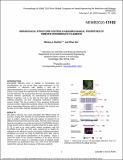Hierarchical Structure Controls Nanomechanical Properties of Vimentin Intermediate Filaments
Author(s)
Buehler, Markus J; Qin, Zhao
Download271_1.pdf (209.8Kb)
PUBLISHER_POLICY
Publisher Policy
Article is made available in accordance with the publisher's policy and may be subject to US copyright law. Please refer to the publisher's site for terms of use.
Terms of use
Metadata
Show full item recordAbstract
Intermediate filaments (IFs), in addition to microtubules and microfilaments, are one of the three major components of the cytoskeleton in eukaryotic cells, playing a vital role in mechanotransduction and in providing mechanical stability to cells (Figure 1) [1]. Despite the importance of IF mechanics for cell biology and cell mechanics, the structural basis for their mechanical properties remains unknown. Specifically, our understanding of fundamental filament properties, such as the basis for their great extensibility, stiffening properties, and their exceptional mechanical resilience remains limited. This has prevented us from answering fundamental structure-function relationship questions related to the biomechanical role of intermediate filaments, which is crucial to link structure and function in the protein material’s biological context.
Date issued
2010-02Department
Massachusetts Institute of Technology. Department of Civil and Environmental EngineeringJournal
ASME 2010 First Global Congress on NanoEngineering for Medicine and Biology
Publisher
ASME International
Citation
Buehler, Markus J., and Zhao Qin. “Hierarchical Structure Controls Nanomechanical Properties of Vimentin Intermediate Filaments.” ASME 2010 First Global Congress on NanoEngineering for Medicine and Biology (2010).
Version: Final published version
ISBN
978-0-7918-4392-5